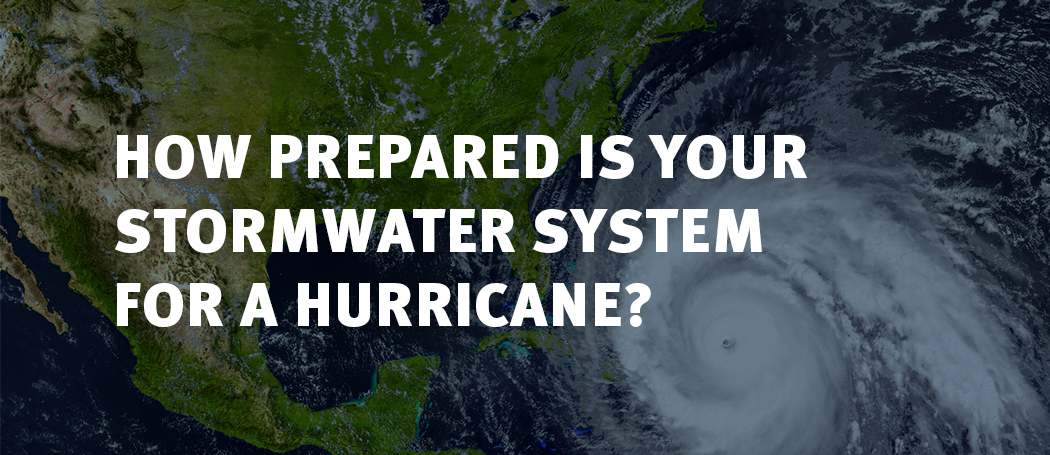How Prepared is Your Stormwater System for a Hurricane?
by Anna Espenhahn, Marketing Coordinator
June marked the start of the Atlantic hurricane season, and with multiple named storms in 2020, this season is expected to be an active season with impacts to the United States. The National Oceanic and Atmospheric Administration, NOAA, predicts an above-average 2020 hurricane season, occurring June 1st through November 30th [1]. NOAA’s Climate Prediction Center has announced an expected range of 13-19 storms with wind speeds reaching 39 mph or higher, while the typical season only produces 12 storms[1]. Of these storms, 6-10 are expected to become hurricanes with 3-6 of those hurricanes having winds reach 111 mph or higher [1]. Increased hurricane activity is expected due to the lack of an El Nino to quell hurricane activity, paired with warmer surface water temperatures in the Atlantic Ocean and Caribbean Sea [1].
How will this affect stormwater? It means there will be a lot of it. A storm’s outer rainbands can range from “a few miles to tens of miles wide and 50-300 miles long,” according to the NOAA [2]. Rainbands often bring at least 6-12 inches of rain per hour to the areas affected, which can lead to flash floods and mudslides [2]. While stormwater systems cannot prevent flash floods, managing stormwater as efficiently and effectively can help minimize the damage caused by large amounts of runoff. Unmaintained systems can instead contribute to flooding, which is why stormwater systems in hurricane-prone areas need precautionary measures before and throughout hurricane season.
Arguably the most important thing you can do to prepare your stormwater system in hurricane season is general maintenance. To regulate water flow and mitigate flooding, clear trash and debris from inlets, outlet, spillways, ponds, storm drains and ditches. If vegetation maintenance is required, bag yard waste to prevent scraps from clogging storm drains and ponds. Test emergency generators and inspect pipes for any signs of damage or weak points.
Preparations apart from general maintenance should also occur. You can read the FEMA Flood Map Service Center’s information on your area to assess susceptibility to flooding. Review your NPDES permit to understand your liabilities during storm events and review any contingency plans that are in place. If storage BMPs are in use, lower water levels to increase holding capacity throughout the system.
Once the hurricane hits, remain in a safe location through the duration of the storm. Do not interact with the stormwater system during the storm. You must not unclog drains while water is flowing. Doing so would release the pressure behind the dammed area, creating a suction power that can pull individuals into pipes. However, any interaction with fast-flowing water comes with the risk of being washed away. Stay safe and do not interact with the water.
Once the storm is fully passed, and water levels have subsided, it is safe to inspect stormwater systems for damages. Before interacting with the system, take photos to keep records of damages that may be liable for insurance claims. Then, check for apparent blockages such as fallen trees, branches, and debris accumulation. Evaluate the water level to see if the total water level surpasses the outfall elevation. Water samples should be taken to evaluate pollutant and toxin levels, and these should be compared to NPDES guidelines. Certified professionals should evaluate structures, including inlets, outlets, pipes, and storm drains that could have been damaged in the storm, and any maintenance or repairs required should be performed.
Natural disasters such as hurricanes can cause immense danger to impacted areas. Simple stormwater preparations allow you to do your part in minimizing those effects. If you need any precautionary or post-storm stormwater maintenance, repairs, or inspection, contact AQUALIS professionals. Stay safe.
For more information, check out the EPA’s Incident Action Checklist – Hurricane to help water and wastewater utilities prepare, respond to, and recover from hurricanes.
References
| [1] |
“Busy Atlantic hurricane season predicted for 2020,” National Oceanic and Atmospheric Administration, 21 May 2020. [Online]. |
| [2] |
N. O. a. A. Administration, Hurricane Basics, 1999. |
 Kenosha, Wis. Highway KR Regenerative Stormwater ConveyanceThe Root-Pike Watershed Initiative Network Kenosha County, and others worked with AQUALIS to design and implement an innovative solution for stormwater control along Highway KR.
Kenosha, Wis. Highway KR Regenerative Stormwater ConveyanceThe Root-Pike Watershed Initiative Network Kenosha County, and others worked with AQUALIS to design and implement an innovative solution for stormwater control along Highway KR. Durham, N.C. Sinkhole Leads to Stormwater System RehabilitationThe tenant on this property noticed a depression that opened to the ground below and notified the property owners.
Durham, N.C. Sinkhole Leads to Stormwater System RehabilitationThe tenant on this property noticed a depression that opened to the ground below and notified the property owners.

